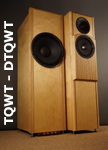After reading many of your projets here on this forum,i m amazed to see how many different projets look very apeeling and are more than hi end audio.I would like to start one also but me skills are very limited in crossovers and all the specs surronding speakers.As for the cabinets and finishes i probably could manage something pretty good.
My question is"Are pre made crossovers a good start for any type of speakers or are they low end and the sound is crap?"Since i never built a crossover before and they seem very technical i find the pre made ones an easy way to start.PE has a nice selection of already made ones.
Could i use one of those for lets say any projet?Or do i have to select certain types of tweeters,mids,woofers and inclosures?
Any help would be very helpful :T
Thanks
Danny
My question is"Are pre made crossovers a good start for any type of speakers or are they low end and the sound is crap?"Since i never built a crossover before and they seem very technical i find the pre made ones an easy way to start.PE has a nice selection of already made ones.
Could i use one of those for lets say any projet?Or do i have to select certain types of tweeters,mids,woofers and inclosures?
Any help would be very helpful :T
Thanks
Danny


 People go for big bad woofers and cheap little tweeters and wonder why a 3/4" dome and a 12" woofer don't quite sound right crossed at 2500Hz 2nd order using a circuit designed for 8ohm flat when the drivers are 6ohm rising on the woofer and 4ohm on the tweet (also not flat of course... probably has Fs right at the XO point...)
People go for big bad woofers and cheap little tweeters and wonder why a 3/4" dome and a 12" woofer don't quite sound right crossed at 2500Hz 2nd order using a circuit designed for 8ohm flat when the drivers are 6ohm rising on the woofer and 4ohm on the tweet (also not flat of course... probably has Fs right at the XO point...)




Comment